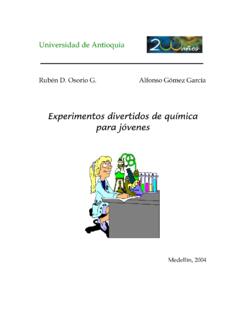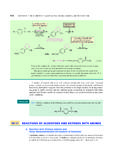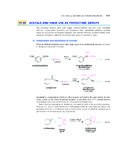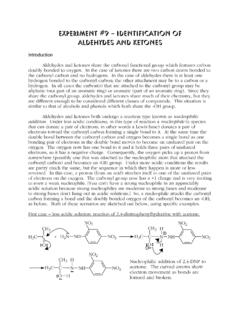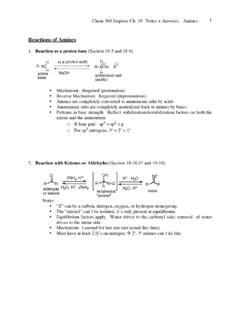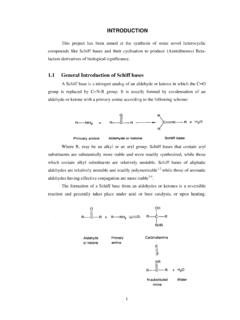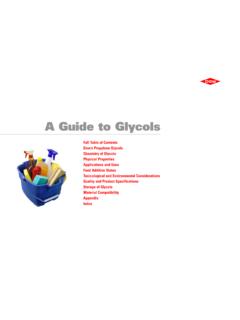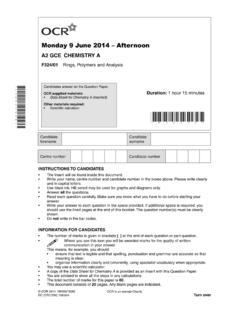Transcription of 1. Acetoacetic Ester Synthesis - Universidad De Antioquia
1 1. Acetoacetic Ester Synthesis Base-catalyzed alkylation or arylation of -ketoesters. Subsequent mild hydrolysis and decarboxylation yield substituted acetones. Alternately, treatment with concentrated base produces substituted esters : Synthetic applications: R. Kluger, M. Brandl, J. Org. Chem. 51, 3964 (1986); T. Yamamitsu et al., J. Chem. Soc. Perkin Trans. I 1989, 1811. Copyright 2001 by Merck & Co., Inc., Whitehouse Station, NJ, USA. All rights reserved. 2. Acyloin Condensation L. Bouveault, R. Loquin, Compt. Rend. 140, 1593 (1905). Reductive coupling of esters by sodium to yield acyloins ( -hydroxyketones). Yields are greatly improved in the presence of trimethylchlorosilane: K. T. Finley, Chem. Rev. 64, 573 (1964); K.
2 Ziegler, Houben-Weyl 4/2, 729-822 (1955); S. M. McElvain, Org. React. 4, 256 (1948); J. J. Bloomfield et al., ibid. 23, 259 (1976); R. Brettle, Comp. Org. Syn. 3, 613-632 (1991). Cf. Benzoin Condensation. Copyright 2001 by Merck & Co., Inc., Whitehouse Station, NJ, USA. All rights reserved. 3. Akabori Amino Acid Reactions S. Akabori, J. Chem. Soc. Japan 52, 606 (1931); Ber. 66, 143, 151 (1933); J. Chem. Soc. 64, 608 (1943). 1. Formation of aldehydes by oxidative decomposition of -amino acids when heated with sugars according to the equation: 2. Reduction of -amino acids and esters by sodium amalgam and ethanolic hydrogen chloride to the corresponding -amino aldehydes: 3. Formation of alkamines by heating mixtures of aromatic aldehydes and amino acids.
3 No reaction was observed with tertiary amino groups. E. Takagi et al., J. Pharm. Soc. Japan 71, 648 (1951); 72, 812 (1952); A. Lawson, H. V. Morley, J. Chem. Soc. 1955, 1695; A. Lawson, ibid. 1956, 307; K. Dose, Ber. 90, 1251 (1957); V. N. Belikov et al., Izv. Akad. Nauk SSSR, Ser. Khim. 1969, 2536. Copyright 2001 by Merck & Co., Inc., Whitehouse Station, NJ, USA. All rights reserved. Reaction (Condensation) R. Kane, Ann. Phys. Chem., Ser. 2, 44, 475 (1838); idem, J. Prakt. Chem. 15, 129 (1838). Traditionally, it is the acid- or base-catalyzed condensation of one carbonyl compound with the enolate/enol of another, which may or may not be the same, to generate a -hydroxy carbonyl compound an aldol. The method is compromised by self-condensation, polycondensation, generation of regioisomeric enols/enolates, and dehydration of the aldol followed by Michael addition, The development of methods for the preparation and use of preformed enolates or enol derivatives, that dictate specific carbon-carbon bond formation, have revolutionized the coupling of carbonyl compounds: Historical perspective: C.
4 H. Heathcock, Comp. Org. Syn. 2, 133-179 (1991). General review: T. Mukaiyama, Org. React. 28, 203-331 (1982). Application of lithium and magnesium enolates: C. H. Heathcock, Comp. Org. Syn. 2, 181-238 (1991); of boron enolates: B. M. Kim et al., ibid. 239-275; of transition metal enolates: I. Paterson, ibid. 301-319. Stereoselective reactions of Ester and thioester enolates: M. Braun, H. Sacha, J. Prakt. Chem. 335, 653-668 (1993). Review of asymmetric methodology: A. S. Franklin, I. Paterson, Contemp. Org. Syn. 1, 317-338 (1994). Cf. Claisen-Schmidt Condensation; Henry Reaction; Ivanov Reaction; Knoevenagel Condensation; Reformatsky Reaction; Robinson Annulation. 5. Algar-Flynn-Oyamada Reaction J. Algar, J. P. Flynn, Proc.
5 Roy. Irish Acad. 42B, 1 (1934); B. Oyamada, J. Chem. Soc. Japan 55, 1256 (1934). Alkaline hydrogen peroxide oxidation of o-hydroxyphenyl styryl ketones (chalcones) to flavonols via the intermediate dihydroflavonols: T. S. Wheeler, Record Chem. Progr. 18, 133 (1957); W. P. Cullen et al., J. Chem. Soc. C 1971, 2848. Mechanism: T. R. Gormley, et al., Tetrahedron 29, 369 (1973); M. Bennett et al., ibid. 54, 9911 (1998). Synthetic applications: H. Wagner et al., ibid. 33, 1405 (1977); A. C. Jain et al., Bull. Chem. Soc. Japan 56, 1267 (1983). Cf. Auwers Synthesis . Copyright 2001 by Merck & Co., Inc., Whitehouse Station, NJ, USA. All rights reserved. 6. Allan-Robinson Reaction J. Allan, R. Robinson, J. Chem. Soc. 125, 2192 (1924).
6 Preparation of flavones or isoflavones by condensing o-hydroxyaryl ketones with anhydrides of aromatic acids and their sodium salts: S. F. Dyke et al., J. Org. Chem. 26, 2453 (1961); Seshandri in The Chemistry of Flavonoid Compounds, T. A. Geissman, Ed. (New York, 1962) p 182; Gripenberg, ibid. p 411; W. Rahman, K. T. Nasim, J. Org. Chem. 27, 4215 (1962); D. L. Dreyer et al., Tetrahedron 20, 2977 (1964). Synthesis applications: P. K. Dutta et al., Indian J. Chem. 21B, 1037 (1982); T. Horie et al., Chem. Pharm. Bull. 37, 1216 (1989); J. K. Makrandi et al., Synth. Commn. 19, 1919 (1989); E. J. Corey et al., Tetrahedron Letters 37, 7162 (1996); B. P. Reddy et al., J. Heterocyclic Chem. 33, 1561 (1996). Cf. Baker-Venkataraman Rearrangement; Kostanecki Acylation.
7 Copyright 2001 by Merck & Co., Inc., Whitehouse Station, NJ, USA. All rights reserved. 7. Allylic Rearrangements L. Claisen, Ber. 45, 3157 (1912). Migration of a carbon-carbon double bond in a three carbon (allylic) system on treatment with nucleophiles under SN1 conditions (or under SN2 conditions when the nucleophilic attack takes place at the -carbon): Reviews: J. R. DeWolfe, W. G. Young, Chem. Rev. 56, 753 (1956); W. G. Young, J. Chem. Ed. 39, 455 (1962); P. de la Mare in Molecular Rearrangements Part 1, P. de Mayo, Ed. (Wiley-Interscience, New York, 1963) pp 27-110; K. Mackenzie in The Chemistry of Alkenes, S. Patai, Ed. (Interscience, New York, 1964) pp 436-453; R. H. DeWolfe, W. G. Young in ibid. pp 681-738; J.
8 March, Advanced Organic Chemistry (Wiley-Interscience, New York, 4th ed., 1992) pp 327-330. Copyright 2001 by Merck & Co., Inc., Whitehouse Station, NJ, USA. All rights reserved. 8. Amadori Rearrangement M. Amadori, Atti Accad. Nazl. Lincei 2(6), 337 (1925), 20, 902 (1926); ibid. 9(6), 68, 226 (1929), 23, 3211, 3443 (1929). Conversion of N-glycosides of aldoses to N-glycosides of the corresponding ketoses by acid or base catalysis: J. E. Hodge, Advan. Carbohyd. Chem. 10, 169 (1955); R. U. Lemieux in Molecular Rearrangements Part 2, P. de Mayo, Ed. (Wiley-Interscience, New York, 1964) p 753. 13C-NMR studies: W. Funcke, Ann. 1978, 2099. Review: K. Maruoka, H. Yamamoto, Comp. Org. Syn. 6, 789-791 (1991). Copyright 2001 by Merck & Co.
9 , Inc., Whitehouse Station, NJ, USA. All rights reserved. 9. Arens-van Dorp Synthesis ; Isler Modification D. A. van Dorp, J. F. Arens, Nature 160, 189 (1947); J. F. Arens et al., Rec. Trav. Chim. 68, 604, 609 (1949); O. Isler et al., Helv. Chim. Acta 39, 259 (1956). The preparation of alkoxyethynyl alcohols from ketones and ethoxyacetylene. In the Isler modification the tedious preparation of ethoxyacetylene is obviated by treating -chlorovinyl ether with lithium amide to yield lithium ethoxyacetylene, which is then condensed with the ketone: H. Heusser et al., Helv. Chim. Acta 33, 370 (1950); J. F. Arens, Advan. Org. Chem. 2, 117-212 (1960); H. Meerwein, Houben-Weyl 6/3, 189 (1965). Cf. Favorskii-Babayan Synthesis ; Nef Synthesis .
10 Copyright 2001 by Merck & Co., Inc., Whitehouse Station, NJ, USA. All rights reserved. 10. Arndt-Eistert Synthesis F. Arndt, B. Eistert, Ber. 68, 200 (1935). Homologation of carboxylic acids: Alternative reagent for diazomethane: T. Aoyama, Tetrahedron Letters 21, 4461 (1980). Application to Synthesis of unsaturated diazoketones: T. Hudlicky et al., ibid. 1979, 2667; K. Gademann et al., Angew. Chem. Int. Ed. 38, 1223 (1999); via ultrasonic activation: J-Y. Winum et al., Tetrahedron Letters 37, 1781 (1996); of amino acids: R. E. Marti et al., ibid. 38, 6145 (1997); R. J. DeVita et al., Bioorg. Med. Chem. Letters 9, 2621 (1999). Reviews: W. E. Bachmann, W. S. Struve, Org. React. 1,38-62 (1942); B. Eistert in Newer Methods in Preparative Organic Chemistry vol.
